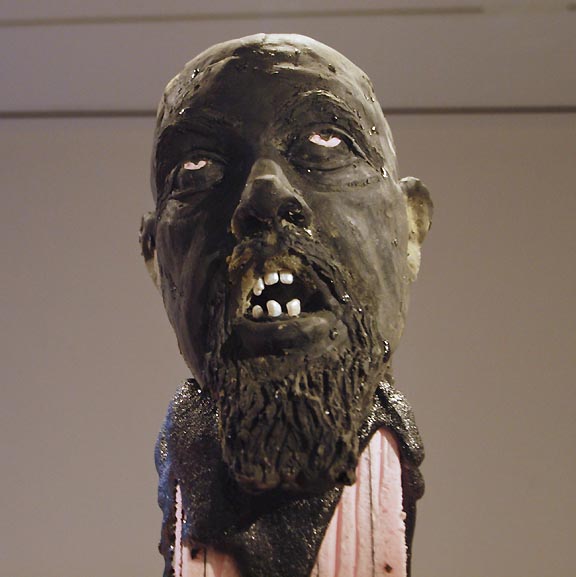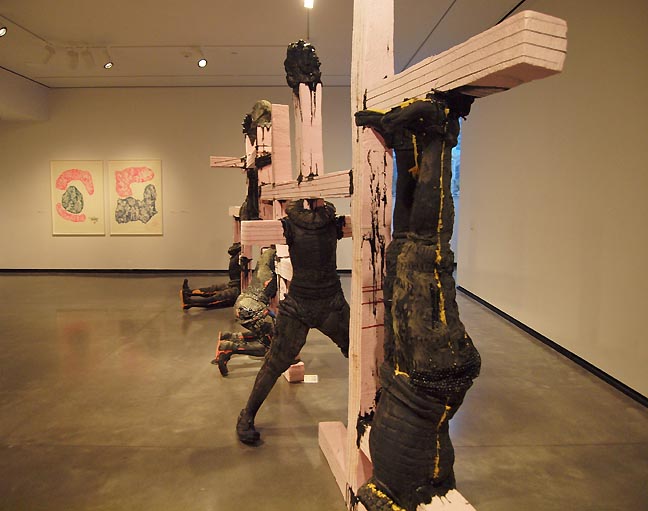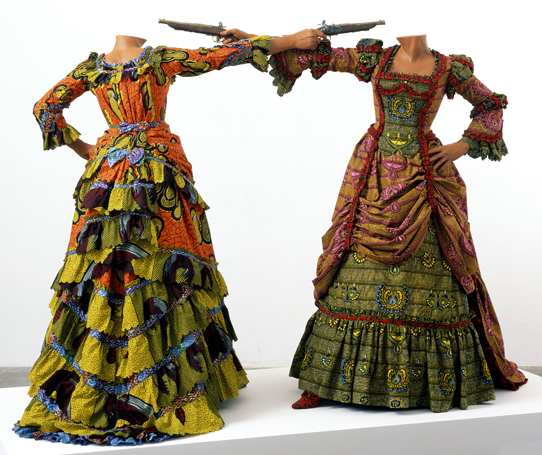
|
||
|
Portland art blog + news + exhibition reviews + galleries + contemporary northwest art
|
||
Folkert de Jong at Portland Art Museum  Detail of Folkert de Jong's Operation Harmony (all photos Jeff Jahn) Believe it or not, the edgiest exhibition in the city of roses is at the Portland Art Museum. For the record this does happen from time to time and the exhibition in question by Dutch artist Folkert de Jong in the Miller-Meigs series space at PAM definitely eludes most easy definitions. With its mutilated bodies, whimsical materials and Dutch post colonial conceits, I'm still uncertain if I find it disturbingly provocative or yet another over-calculated international art farce, strategically designed to titillate and disgust? Ah, but such is the worth of art... its indeterminate value both moral and formally then becomes subjectively ingrained within the viewer's experience as a challenge to what we know and experience. Yet, in an exhibition like this one can apply "History" to give it scale and context, demanding a kind of reckoning upon which our subjective matrix can be applied, compared and contrasted. History uncovers as well as it obscures.  Operation Harmony Stepping back clinically, all viewers will encounter some similar information when viewing these works. Dominating the exhibition is Operation Harmony, a scaffolding of pink foam with mutilated 17th century Dutch explorers grotesquely decapitated and prostrated in a way that unmistakeably says, "This is a warning." All this is accomplished in the way a head on a pike can unambiguously convey.  Operation Harmony (detail) Some of the heads are amusing, with little grimaces too... so there is a comedic element as well that doesn't seem as developed as the more gruesome aspects of the work. Instead of satire it seems like a marketing ploy to lighten the mood. Each year thousands of recent MFA's use this same foam material. In addition, the difficult to look at blackened skin effectively conveys a sense of severe necrosis and the brilliant pearls as teeth tantalizes with riches. It is a dramatic push pull and without the pearls I don't think the piece would work. For example the pink scaffolding is supposed to evoke Dutch neoplasticist art but I feel like that is overreaching. Not only did de Stijl never use pink foam, they never made anything even similarly provisional. Instead, it reminds us of the foam's typical purpose as an insulating construction material... as a kind of modern day surrogate for colonization... we just call it real estate today!  (installation view) Business As Usual, "The Tower" (FG) The second sculpture, Business As Usual, "The Tower" sports 3 monkeys with the familiar hear no evil, see no evil speak no evil motif atop an oil barrel. It is just too obvious. Yes... we rely on oil, it is dirty business and through its influence, nobody is clean but the piece lacks the punch, layers and finesse of Operation Harmony. Lastly, the 3 lithographs depicting the Dutch negotiating with natives in the south seas (recalling the Dutch purchase of the island of Manhattan) are also present but are completely overshadowed. They are fine but hardly add anything new to the post-colonial discussion. Now if de Jong let some Taiwanese residents negotiate with his Chelsea art dealer James Cohen over his art in a reversal of the ways Pieter Nuyts (infamous 17th-Century Dutch Governor of then Formosa) conducted business... THAT would be interesting. Somehow this exhibition is simultaneously both too much and not enough, for me at least. You see, as a critic I try to take art as personally as possible, it is a way to measure experiences against what I already know or have experienced. Think of Art as continually dipping into the well of subjectivity and for me this exhibition tellingly conjures incredibly powerful experiences like my visits to the Dachau Concentration Camp, The Pirates of the Caribbean ride at Disneyland and the Terry Gilliam movie Time Bandits... and as such it doesn't quite live up to such lofty/infamous comparisons.  (FG) Operation Harmony Mostly these reactions are stirred by Operation Harmony. The cultured pearls for teeth glint from a distance and pull you in for a grotesque closer look (like the animatronics for Pirates of the Caribbean ride). Similar to the ride, the closer you get the more horrible it becomes as the mutilated Dutch colonizers are blackened like corpses in the sun, or have they been tarred with unrefined crude oil? More importantly the figures form a kind of fence made from bodies recalling the famous Nandor Glid sculpture at the Dachau Concentration Camp, Monument to the Victims of Dachau. For me, experiencing the grounds of Dachau was a protean event... no words describe the calculated dehumanization and systematic wasting of so many lives. I remember thinking, "this may seem unbelievable but you know this has happened time and again in history and to forget history is to render human life worthless." The realization that throughout history humans have exterminated what is different along genetic lines as a means to acquire property meant that this genocide would likely happen again.  Memorial sculpture at Dachau At Dachau, I reeled with an awful awareness of the human capacity for dehumanization. I wondered if we had that many redeeming qualities by comparison? ...and then I saw Glid's sculpture. It was nearly as awful, just as pitiless and on permanent display (unlike the bodies of Dachau's victims). I thought something like, "oh so visual art can go there, almost like the weakened strain of a bacteria used for inoculation against turning a blind eye to genocide." Thus, the sculpture dealt with the inhumanity and left the questions up to me... or any viewer bringing the situation into an active present.  Yinka Shonibare's How to Blow Up Two Heads at Once (Ladies), 2006 In many ways Operation Harmony operates in a similar vein (an eccyclema in greek theater) to the Dachau sculpture and it is why the monkey piece just doesn't stack up as well in comparison. Also, there are other contemporary artists like Yinka Shonibare whose work deals with the same complicated post-colonial subject matter, only from a more African and aesthetic perspective. Both artists offer a kind of disinfected version of post-colonial issues (Ala the pirates of the Caribbean ride) that renders their works like cartoony reminders of truly terrible things. Still, I find that Shonibare presents things with a more cutting and dead serious humor that is still refined... de Jong not so much and it is why he has something in common with Paul McCarthy. The thing is McCarthy is far more over the top and abrasive and de Jong isnt in his league either. Still is the cruel satire of Operation Harmony enough to fully condone de Jonge's work here? This work is interesting but clearly de Jong is no Francisco Goya whose black paintings and Third of May 1808 or even Picasso whose Guernica remain the benchmarks for judging historical inhumanity in art. Even MacArthur winner Alfredo Jaar's work has dealt with humanity's crimes against itself with an unblinking directness that gets muddled in a kind of cute didacticism in de Jong's work. Overall, I find that Operation Harmony has a glibness not unlike the conclusion of the classic movie Time Bandits... but somehow the black chunks of the "Pure Evil" in that film ring funnier and truer than they do here. Unlike Nandor, Jaar, Goya, Picasso etc Mr. de Jong seems to flinch a bit and care a little bit too much about art history and not enough history in general... and trying to bring De Stijl or other art historical references into it does weaken the sauce. In other pieces he has evoked Brancusi which just seems like a grab for art historical context that might work well in art fairs... but not so well in Museums. It also lacks Terry Gilliam genius level ability to convey the fantastic and soberingly historical through farce. Still, de Jonge makes a pretty stiff if a tad pretentious cocktail and its unrefined elements are a welcome disturbance to an art world that seems rather innocuous of late.... kinda the way Damien Hirst's Shark has been redone with its gaping jaws closed. As a huge Hirst fan I was incredibly disappointed in the effect that revision had. Yet, I have to recommend the show at PAM even if I can't be a huge fan of it. Besides, most Americans are still unaware of how Dutch and other European colonialism has shaped our world today especially in oil rich countries. Now extended at PAM through June 23rd Posted by Jeff Jahn on May 18, 2013 at 14:22 | Comments (0) Comments Post a comment Thanks for signing in, . Now you can comment. (sign out)
(If you haven't left a comment here before, you may need to be approved by
the site owner before your comment will appear. Until then, it won't appear
on the entry. Thanks for waiting.)
|
| s p o n s o r s |
 |
 |
 |
 |
 |
 |
 |
 |
 |
 |
 |
 |
 |
 |
 |
 |

|
Site Design: Jennifer Armbrust | • | Site Development: Philippe Blanc & Katherine Bovee | |

